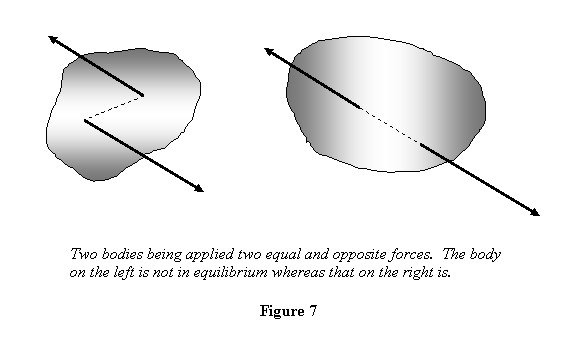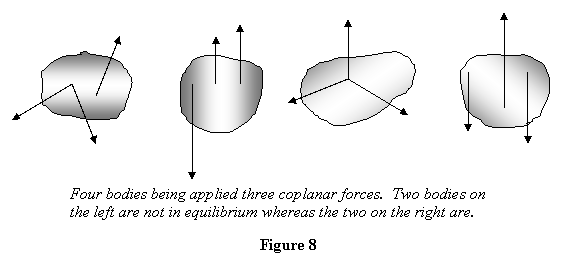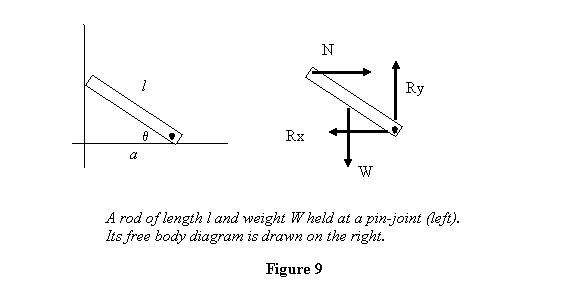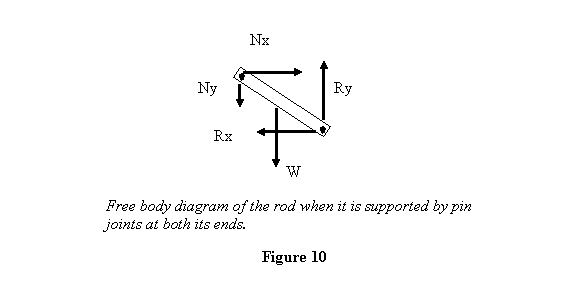Let
me now summarize what all you
have learnt so far in considering
the equilibrium of engineering
structures. In the process I
also introduce you to a term
called the Free Body
Diagram. I have actually
been using it without calling it so. Now,
let us formalize it.
In talking about the equilibrium of a body we consider
all the external forces applied on it and the interaction
of the body with other objects around it. This interaction
produces more forces and torques on the body. Thus
when we single out a body in equilibrium, objects
like hinges, ball-socket joint, fixed supports around
it are replaced elements by the corresponding forces & torques
that they generate. This is what is called a free-body
diagram. Making a free-body diagram allows us to
focus our attention only on the information relevant
to the equilibrium of the body, leaving out unnecessary
details. Thus making a free-body diagram is pretty
much like Arjuna - when asked to take an aim on the
eye of a bird - seeing only the eye and nothing else.
The diagrams made on the right side of figures 1,
2 and 3 are all free-body diagrams.
In the coming lecture we will be applying the techniques
learnt so far to a very special structure called
the truss. To prepare you for that, in the following
I consider the special case of a system in equilibrium
under only two forces. For completeness I will also
take up equilibrium under three forces.
When only two forces are applied, no matter what the
shape or the size of the object in equilibrium is,
the forces must act along the same line, in directions
opposite to each other, and their magnitudes must
be the same. That the forces act in directions opposite
to each other and have equal magnitude follows from
the equilibrium conditions  ,
which implies that
,
which implies that  .
Further, if the forces are not along the same line
then they will form a couple that will tend to rotate
the body. Thus
.
Further, if the forces are not along the same line
then they will form a couple that will tend to rotate
the body. Thus  implies
that the forces act along the same line, i.e. they
be collinear (see figure 7).
implies
that the forces act along the same line, i.e. they
be collinear (see figure 7).

Similarly
if there are three forces acting on a body that is
in equilibrium then the three forces must be in the
same plane and concurrent. If there are not concurrent
then they must be parallel (of course remaining in
the same plane). This can be understood as follows.
Any two members of the three applied forces form
a plane. If the third force is not in the same plane,
it will have a non-vanishing component perpendicular
to the plane; and that component does not get cancelled.
Thus unless all three forces are in the same plane,
they cannot add up to zero. So to satisfy the equation  ,
the forces must be in the same plane, i.e. they must
be coplanar. For equilibrium the torque about any
point must also be zero. Since the forces are in
the same plane, any two of them will intersect at
a certain point O. These two forces will
also have zero moment about O. If the third
force does not pass through O, it will
give a non-vanishing torque (see figure 8). So to
satisfy the torque equation, the forces have to be
concurrent. Zero torque condition can also be satisfied
if the three forces are parallel forces (see figure
8); that is the other possibility for equilibrium
under three forces.
,
the forces must be in the same plane, i.e. they must
be coplanar. For equilibrium the torque about any
point must also be zero. Since the forces are in
the same plane, any two of them will intersect at
a certain point O. These two forces will
also have zero moment about O. If the third
force does not pass through O, it will
give a non-vanishing torque (see figure 8). So to
satisfy the torque equation, the forces have to be
concurrent. Zero torque condition can also be satisfied
if the three forces are parallel forces (see figure
8); that is the other possibility for equilibrium
under three forces.

In the end, I now discuss one more concept about equilibrium
of bodies, that of statical determinacy .
Along the way I also introduce some connected concepts
like constraints, degree of redundancy and redundant
support. On constraints, I will discuss more in the
lecture on Method of virtual work.
To introduce the terms used above, I consider a rod
of length l and weight W held
at a pin-joint on a floor at a distance of a from
a wall, on which its other end is. This is shown
in figure 9 along with the free-body diagram of the
rod.

There are three unknowns - Rx, Ry and N - in the problem
and three equations of equilibrium that will determine
the unknowns. Specifically:

Taking moment about the pin, we get

This gives

In this case, the constraints or the external supports
we apply are just sufficient to keep the system in
equilibrium. Such systems are known as statically
determinate systems. Now suppose we apply
one more support. Let us support the rod at both
ends by pin joints. The free-body diagram will then
look like that shown in figure 10.

Now the pin on top end is also applying a force on
the rod. Thus the equations of equilibrium read as

The situation on hand is that we have four unknowns
- Rx, Ry, Nx and Ny - and only three equations. Thus
one of the unknown cannot be determined. In particular
only  is
known and what are individual
is
known and what are individual  cannot
be determined unless some additional information
is also given. Such systems are known as statically
indeterminate systems. In such systems
we are applying more constraints than are needed
to keep the system in equilibrium. Even if we remove
one of the constraints - in this case replace the
upper pin by a plane surface - the system is capable
of remaining in equilibrium. Such supports that can
be removed without disturbing the equilibrium are
known as redundant supports. And the number of redundant
supports is the degree of statical indeterminacy .
cannot
be determined unless some additional information
is also given. Such systems are known as statically
indeterminate systems. In such systems
we are applying more constraints than are needed
to keep the system in equilibrium. Even if we remove
one of the constraints - in this case replace the
upper pin by a plane surface - the system is capable
of remaining in equilibrium. Such supports that can
be removed without disturbing the equilibrium are
known as redundant supports. And the number of redundant
supports is the degree of statical indeterminacy .
After introducing you to the concepts discussed above,
we will be studying trusses in the next lecture.